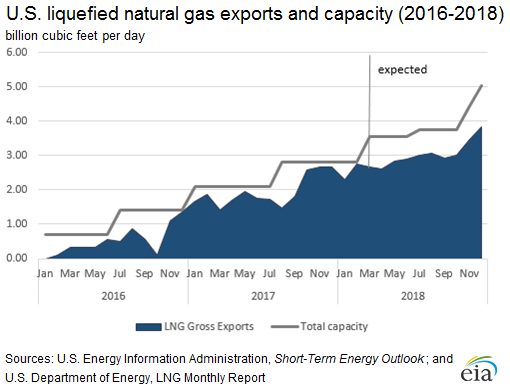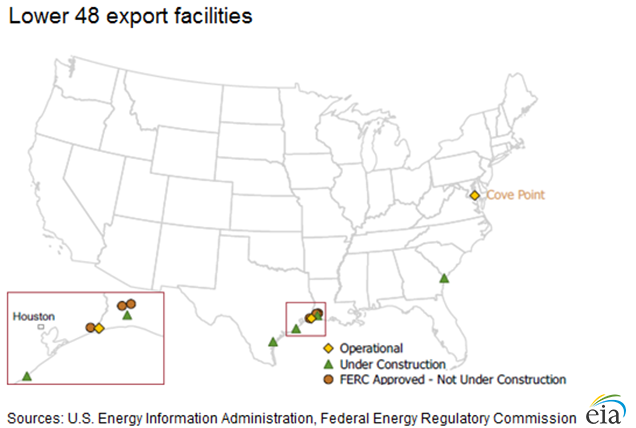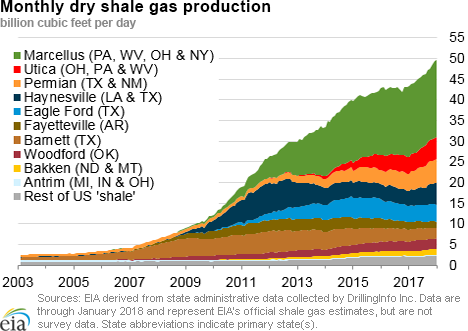In the News:
Dominion Energy’s Cove Point LNG export facility begins commercial operations
The Dominion Energy Cove Point liquefied natural gas (LNG) facility in Maryland exported its first LNG cargo during its final stage of commissioning on March 1, 2018, on Royal Dutch Shell Plc’s LNG carrier, Gemmata, with a capacity of 3.0 billion cubic feet (Bcf). Its destination and buyer are unknown. The Federal Energy Regulatory Committee (FERC) granted approval for Cove Point to officially begin commercial operations on March 5. The Methane Spirit will likely be the next vessel to export Cove Point LNG at the end of March.
Cove Point has a design capacity to liquefy up to 0.75 billion cubic feet per day (Bcf/d) of natural gas. The natural gas is sourced from the high-producing Marcellus and Utica shale plays. Cove Point is the only LNG export facility on the east coast of the United States and the second export facility operating in the Lower 48 states after Sabine Pass in Louisiana, which began commercial operations in 2016.
Cove Point began receiving natural gas feedstock deliveries for LNG production in early December 2017. Two LNG cargoes were imported into Cove Point in December 2017 and January 2018 as cool down cargoes, which is the standard practice for preparing and testing liquefaction equipment systems for LNG production. According to S&P Global Platts Bentek Energy, the implied pipeline feedgas deliveries to the Cove Point terminal averaged 0.25 Bcf/d in February and increased to 0.45 Bcf/d in the two weeks leading up to the export. On the day of export, the pipeline deliveries decreased from a high of 920 million cubic feet per day (MMcf/d) to 18 MMcf/d.
The U.S. Department of Energy’s Office of Fossil Energy approved Cove Point to export up to 0.77 Bcf/d to non-Free Trade Agreement (FTA) countries. Cove Point liquefaction output is fully subscribed under 20-year service agreements. Half of the marketed capacity will go to a joint venture of Sumitomo Corporation and Tokyo Gas and the other half to India’s state-owned GAIL (India) Ltd. LNG contracted by Japanese buyers will likely be used for power generation in the Tokyo and Kansai metropolitan areas. GAIL is seeking to resell 24 of its Cove Point cargos in tranches of 6 to 12 in 2019 and 2020, which is approximately 40% of its subscribed volume over this time period, assuming average-sized cargos.
EIA’s Short-Term Energy Outlook projects that LNG exports will average 2.9 Bcf/d in 2018, up 1 Bcf/d from 2017 levels. By 2019, LNG exports are expected to average 4.8 Bcf/d as new liquefaction capacity comes online.
Overview:
(For the Week Ending Wednesday, March 7, 2018)
- Natural gas spot prices rose at most locations this report week (Wednesday, February 28 to Wednesday, March 7). The Henry Hub spot price rose from $2.61 per million British thermal units (MMBtu) last Wednesday to $2.77/MMBtu yesterday.
- At the New York Mercantile Exchange (Nymex), the April 2018 contract price rose 11¢ from $2.667/MMBtu last Wednesday to $2.777/MMBtu yesterday.
- Net withdrawals from working gas totaled 57 billion cubic feet (Bcf) for the week ending March 2. Working natural gas stocks are 1,625 Bcf, which is 30% less than the year-ago level and 16% less than the five-year (2013–17) average for this week.
- The natural gas plant liquids composite price at Mont Belvieu, Texas, fell by 73¢, averaging $7.18/MMBtu for the week ending March 7. The price of propane, butane, and isobutane fell by 17%, 10%, and 16%, respectively. The price of natural gasoline rose by 5%. The price of ethane remained flat week over week.
- According to Baker Hughes, for the week ending Tuesday, February 27, the natural gas rig count increased by 2 to 181. The number of oil-directed rigs rose by 1 to 800—the highest level since April 2015. The total rig count increased by 3, and it now stands at 981.
Prices/Supply/Demand:
Spot prices rise around the country. This report week (Wednesday, February 28 to Wednesday, March 7), spot prices rose around the country as temperatures fell. The Henry Hub spot price rose 16¢ from $2.61/MMBtu last Wednesday to $2.77/MMBtu yesterday. At the Chicago Citygate, prices increased 24¢ from $2.40/MMBtu last Wednesday to $2.64/MMBtu yesterday. Prices at PG&E Citygate in Northern California rose 9¢, up from $2.77/MMBtu last Wednesday to $2.86/MMBtu yesterday. The price at SoCal Citygate increased 41¢ from $2.56/MMBtu last Wednesday to $2.97/MMBtu yesterday, reaching a high of $3.39/MMBtu on Friday. Continued capacity constraints and colder temperatures in Southern California have led to price volatility in recent weeks.
Northeast prices rise. At the Algonquin Citygate, which serves Boston-area consumers, prices went up $1.88 from $2.32/MMBtu last Wednesday to $4.20/MMBtu yesterday, as the region experienced colder temperatures. In addition, the Pilgrim nuclear plant in Plymouth, Massachusetts, was taken offline unexpectedly on Tuesday as a result of possible leaks in the feed water heating system and remained offline as of yesterday. The shutdown of this nuclear power plant likely increased demand for other sources of electricity, including natural gas-fired power plants. At the Transcontinental Pipeline Zone 6 trading point for New York, prices increased 39¢ from $2.70/MMBtu last Wednesday to $3.09/MMBtu yesterday with a low of $2.66/MMBtu on Friday.
Tennessee Zone 4 Marcellus spot prices increased 28¢ from $1.98/MMBtu last Wednesday to $2.26/MMBtu yesterday. Prices at Dominion South in northwest Pennsylvania rose 20¢ from $2.10/MMBtu last Wednesday to $2.30/MMBtu yesterday.
Nymex prices rise. At the Nymex, the price of the April 2018 contract increased 11¢, from $2.667/MMBtu last Wednesday to $2.777/MMBtu yesterday. The price of the 12-month strip averaging April 2018 through March 2019 futures contracts climbed 10¢ to $2.934/MMBtu.
Supply remains flat. According to data from PointLogic Energy, the average total supply of natural gas remained the same as in the previous report week, averaging 84.4 Bcf/d. Dry natural gas production remained constant week over week. Average net imports from Canada increased by 8% from last week.
Demand rises. Total U.S. consumption of natural gas rose by 2% compared with the previous report week, according to data from PointLogic Energy. Natural gas consumed for power generation declined by 5% week over week. Industrial sector consumption increased by 1% week over week. In the residential and commercial sectors, consumption increased by 10% as temperatures generally became colder, except on the West Coast. Natural gas exports to Mexico were the same as last week, averaging 4.3 Bcf/d.
U.S. LNG exports increase week over week. One vessel (LNG-carrying capacity 3.5 Bcf) departed the Sabine Pass liquefaction facility about midnight on February 28 and five LNG vessels (LNG-carrying capacity 18.5 Bcf combined) departed the facility from March 1 to March 7. One vessel (LNG-carrying capacity 3.7 Bcf) was loading at the terminal on Wednesday.
Dominion Energy Cove Point facility loaded its first commissioning cargo onto an LNG vessel, Gemmata (LNG carrying capacity 3.0 Bcf), which departed the facility on March 1 and appears to be en route to South America.
Storage:
Working gas net withdrawals are 72 Bcf lower than the five-year average. Net withdrawals from storage totaled 57 Bcf for the week ending March 2, compared with the five-year (2013–17) average net withdrawal of 129 Bcf and last year's net withdrawals of 57 Bcf during the same week. Working gas stocks totaled 1,625 Bcf, which is 300 Bcf less than the five-year average and 680 Bcf less than last year at this time. Working gas stocks in all regions in the Lower 48 states are lower than year-ago levels.
Working gas levels are 484 Bcf higher than the five-year minimum. Working gas stocks have rebounded since falling 59 Bcf lower than the five-year minum range and 486 Bcf lower than the five-year average for the Lower 48 states on January 19, 2018. If net withdrawals from working gas stocks match the five-year average for the remainder of the withdrawal season, working gas stocks will total 1,402 Bcf by March 31, 2018, which is 18% lower than the five-year average. Working gas stocks ended the 2013–14 heating season at 837 Bcf, which is the lowest-reported level for that time.
The average April 2018 futures contract price trades at a premium to the average weekly spot price. During the most recent storage week, the average natural gas spot price at the Henry Hub was $2.59/MMBtu, 7¢/MMBtu lower than the front-month futures price at the Nymex. A year ago, the spot price was 17¢ lower than the front-month contract.
Reported withdrawals out of storage are close to the median of analysts’ expectations. According to the Desk survey of natural gas analysts, estimates of the weekly net change in working natural gas storage ranged from 49 Bcf to 64 Bcf, with a median of 58 Bcf. Prices for the futures contract for April delivery at the Henry Hub remained relatively unchanged, averaging $2.75 million British thermal units (MMBtu), following the release of the Weekly Natural Gas Storage Report, in relatively light trading. Prices varied in subsequent trading and were between $2.74/MMBtu and $2.76/MMBtu.
Temperatures were higher than normal during the storage week throughout most of the Lower 48 states east of the Rocky Mountains. Temperatures in the Lower 48 states averaged 45 degrees Fahrenheit (°F), 5°F higher than the normal, 2°F lower than last year at this time, and 1°F higher than the average temperature of the prior storage week.
See also:
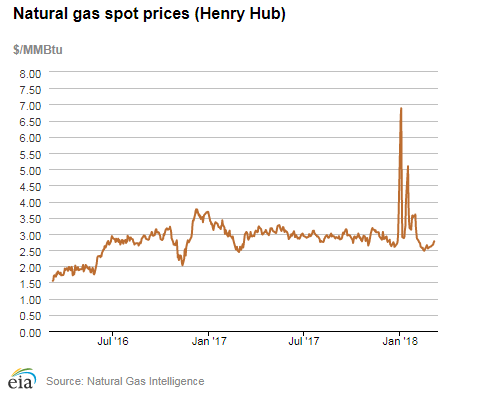
| Spot Prices ($/MMBtu) | Thu, 01-Mar |
Fri, 02-Mar |
Mon, 05-Mar |
Tue, 06-Mar |
Wed, 07-Mar |
|---|---|---|---|---|---|
| Henry Hub |
2.61 |
2.63 |
2.67 |
2.73 |
2.77 |
| New York |
2.72 |
2.66 |
2.77 |
3.03 |
3.09 |
| Chicago |
2.41 |
2.42 |
2.49 |
2.61 |
2.64 |
| Cal. Comp. Avg.* |
2.48 |
2.68 |
2.47 |
2.56 |
2.57 |
| Futures ($/MMBtu) | |||||
| April contract | 2.698 |
2.695 |
2.704 |
2.749 |
2.777 |
| May contract |
2.729 |
2.727 |
2.738 |
2.778 |
2.806 |
| *Avg. of NGI's reported prices for: Malin, PG&E Citygate, and Southern California Border Avg. | |||||
| Source: NGI's Daily Gas Price Index | |||||
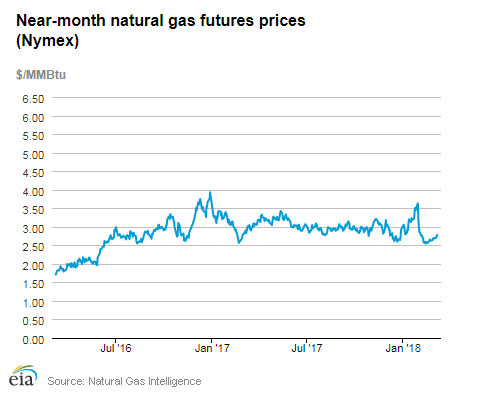
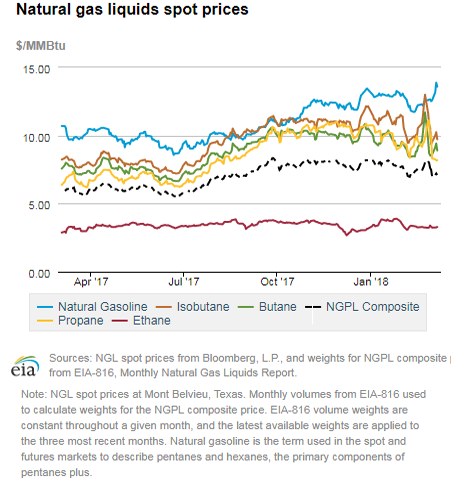
| U.S. natural gas supply - Gas Week: (3/1/18 - 3/7/18) | |||
|---|---|---|---|
Average daily values (Bcf/d): |
|||
this week |
last week |
last year |
|
| Marketed production | 87.7 |
88.2 |
80.4 |
| Dry production | 78.1 |
78.5 |
71.7 |
| Net Canada imports | 6.1 |
5.6 |
5.3 |
| LNG pipeline deliveries | 0.2 |
0.5 |
0.4 |
| Total supply | 84.4 |
84.6 |
77.4 |
|
Source: OPIS PointLogic Energy, an IHS Company | |||
| U.S. natural gas consumption - Gas Week: (3/1/18 - 3/7/18) | |||
|---|---|---|---|
Average daily values (Bcf/d): |
|||
this week |
last week |
last year |
|
| U.S. consumption | 76.5 |
74.9 |
73.6 |
| Power | 22.6 |
23.9 |
22.0 |
| Industrial | 22.0 |
21.8 |
21.6 |
| Residential/commercial | 32.0 |
29.2 |
30.0 |
| Mexico exports | 4.3 |
4.3 |
4.2 |
| Pipeline fuel use/losses | 6.7 |
5.9 |
6.4 |
| LNG pipeline receipts | 3.4 |
3.6 |
1.5 |
| Total demand | 90.9 |
88.7 |
85.8 |
|
Source: OPIS PointLogic Energy, an IHS Company | |||
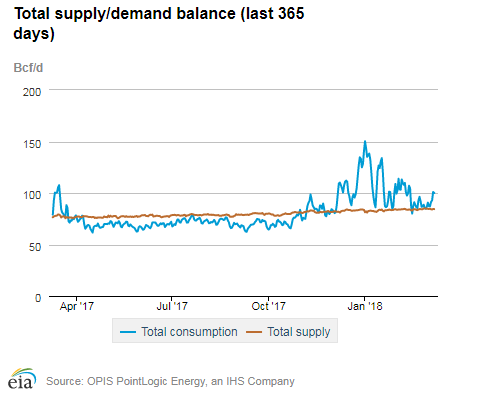
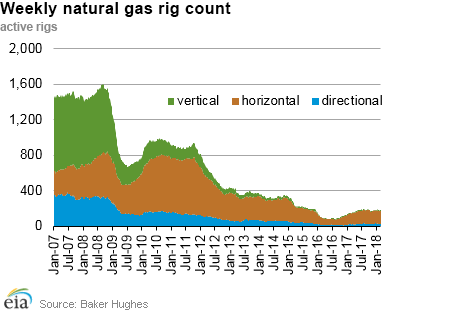
| Rigs | |||
|---|---|---|---|
Fri, March 02, 2018 |
Change from |
||
last week |
last year |
||
| Oil rigs | 800 |
0.1% |
31.4% |
| Natural gas rigs | 181 |
1.1% |
24.0% |
| Note: Excludes any miscellaneous rigs | |||
| Rig numbers by type | |||
|---|---|---|---|
Fri, March 02, 2018 |
Change from |
||
last week |
last year |
||
| Vertical | 59 |
-11.9% |
-4.8% |
| Horizontal | 847 |
0.6% |
33.8% |
| Directional | 75 |
8.7% |
23.0% |
| Source: Baker Hughes Inc. | |||
| Working gas in underground storage | ||||
|---|---|---|---|---|
Stocks billion cubic feet (Bcf) |
||||
| Region | 2018-03-02 |
2018-02-23 |
change |
|
| East | 359 |
382 |
-23 |
|
| Midwest | 380 |
398 |
-18 |
|
| Mountain | 97 |
102 |
-5 |
|
| Pacific | 177 |
189 |
-12 |
|
| South Central | 612 |
611 |
1 |
|
| Total | 1,625 |
1,682 |
-57 |
|
| Source: U.S. Energy Information Administration | ||||
| Working gas in underground storage | |||||
|---|---|---|---|---|---|
Historical comparisons |
|||||
Year ago (3/2/17) |
5-year average (2013-2017) |
||||
| Region | Stocks (Bcf) |
% change |
Stocks (Bcf) |
% change |
|
| East | 407 |
-11.8 |
379 |
-5.3 |
|
| Midwest | 583 |
-34.8 |
446 |
-14.8 |
|
| Mountain | 140 |
-30.7 |
128 |
-24.2 |
|
| Pacific | 202 |
-12.4 |
217 |
-18.4 |
|
| South Central | 973 |
-37.1 |
756 |
-19.0 |
|
| Total | 2,305 |
-29.5 |
1,925 |
-15.6 |
|
| Source: U.S. Energy Information Administration | |||||
| Temperature – heating & cooling degree days (week ending Mar 01) | ||||||||
|---|---|---|---|---|---|---|---|---|
HDD deviation from: |
CDD deviation from: |
|||||||
| Region | HDD Current |
normal |
last year |
CDD Current |
normal |
last year |
||
| New England | 178 |
-61 |
49 |
0 |
0 |
0 |
||
| Middle Atlantic | 156 |
-69 |
44 |
0 |
0 |
0 |
||
| E N Central | 157 |
-83 |
3 |
0 |
0 |
0 |
||
| W N Central | 219 |
-22 |
12 |
0 |
0 |
0 |
||
| South Atlantic | 74 |
-67 |
10 |
21 |
12 |
6 |
||
| E S Central | 52 |
-84 |
-19 |
4 |
1 |
0 |
||
| W S Central | 61 |
-28 |
15 |
11 |
5 |
-9 |
||
| Mountain | 231 |
49 |
10 |
0 |
-1 |
0 |
||
| Pacific | 153 |
56 |
7 |
0 |
-1 |
0 |
||
| United States | 145 |
-34 |
14 |
5 |
2 |
0 |
||
|
Note: HDD = heating degree day; CDD = cooling degree day Source: National Oceanic and Atmospheric Administration | ||||||||
Average temperature (°F)
7-Day Mean ending Mar 01, 2018
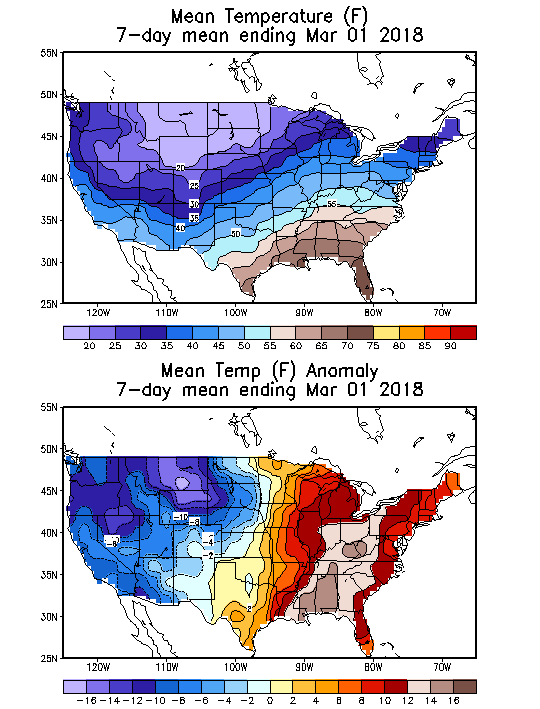
Source: NOAA National Weather Service
Deviation between average and normal (°F)
7-Day Mean ending Mar 01, 2018

Source: NOAA National Weather Service

